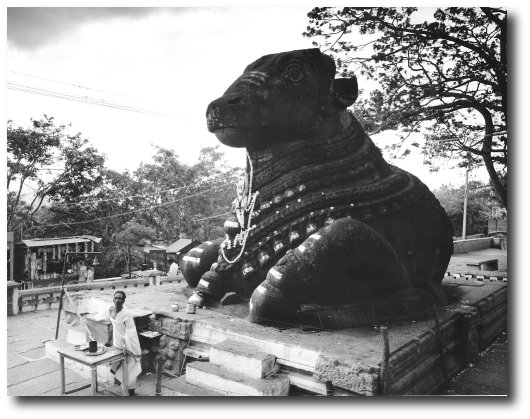
TMax100 film, 1/15, orange filter, f/22
110mm Schneider Super Symmar XL f/5.6
| Home |
| Last update: 04 October, 2005 |
Large Format Camera work in South India

|
|
Nandi - Chamundi Hill, Mysore, India TMax100 film, 1/15, orange filter, f/22 110mm Schneider Super Symmar XL f/5.6 |
I travel once or twice a year on business. My primary destination is usually somewhere in South India. I have taken up a role as a regional coordinator related to engineering product development activities for the company I work for. To me, Indians are a warm, friendly, fun loving people. So when travel presents itself I really look forward to visiting with friends and colleagues in that part of the world.
I am also a photographer by hobby. After long days of managing engineers (which is akin to herding cats) the old analog technologies involved in traditional silver photography are a soothing way to spend the "off" hours. The act of taking a picture, processing the negatives, and making a print are fun to me. And I have a few benefits. Because of my job and due to some nice gains realized on eBay during the late 1990's I have more than my fair share of fun camera equipment. The camera collection includes everything from 35mm through ultra large formats (11x14 and 7x17). No one person has a right to enjoy photography as much as I do. I feel lucky.
When traveling, the question about which camera to take always comes up. I prefer making large negatives because of the smooth tones which images have when enlarged up to 16x20. To me, the larger the negative the better. But with larger formats come increases in supporting photographic "infrastucture" costs. Everything gets "bigger". So when I travel one of my primary concerns is about the overall weight of the gear I carry. When I fly I carry on my suitcase and over the shoulder bag, and I'm not built for strength.
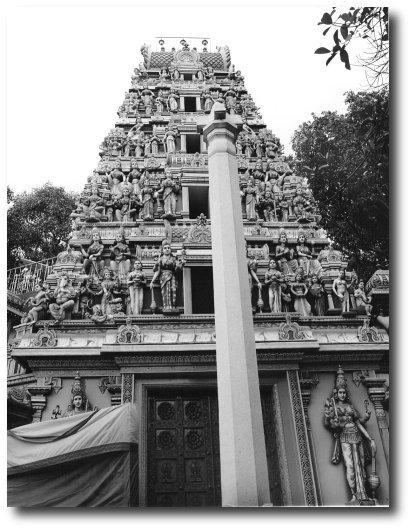
|
|
Temple facade - Bangalore, India TMax100 film, 1/8sec, f/22 110mm Schneider Super Symmar XL f/5.6 (right) |
In the past I have carried a Mamiya 7 with 80mm lens. This kit is very light, compact, and the lens is brilliantly sharp. I can attach a flash for situations where a little extra light is needed. This setup allows me to work like a street photographer. I can grab an image and run, as it were. The built-in light meter is accurate enough to allow this approach. All I need to do is check the aperture, focus the lens, and hit the shutter release. The Mamiya 7 is like a giant 120 format Point and Shoot. There are a few images from trips where this simple camera setup is all I used. I have been quite happy with the results.
After my first couple trips where I carried just the Mamiya 7 with the single lens, I acquired a beautiful 50mm L. The two lens kit weighed less than four pounds and was still reasonably light. But I found that in using the Mamiya 7 and the two lens kit (80mm and 50mm) that I would feel like I was loosing time as photographic situations evolved rapidly while I was attempting to change the lens. With a little planning around how to approach various photo situations I found this setup was usable. I was eventually able to learn how to work nearly as quickly as with the single lens setup.
As I have far too much camera gear for my own good, I recently tried
another camera kit combination. I flew around the globe with
the Mamiya 7 and the 50mm lens, and added a nice
Rolleiflex 3.5F. The Planar lens on the Rollei is very sharp and
contrasty. In most situations I can't tell the difference between the
Planar and Mamiya images. Although the Planar is single coated it
did very well indeed. But the Planar is prone to flair if pointed toward
the sun. A lens shade is required equipment. Once I figured this out,
the two camera kit worked just about perfectly. The whole
setup was relatively light (under 5 pounds total) and allowed me to
work very rapidley I was able to grab the camera with the "right" perspective
as the scenes changed. But as nearly perfect as this setup was, there
was still something not quite right.
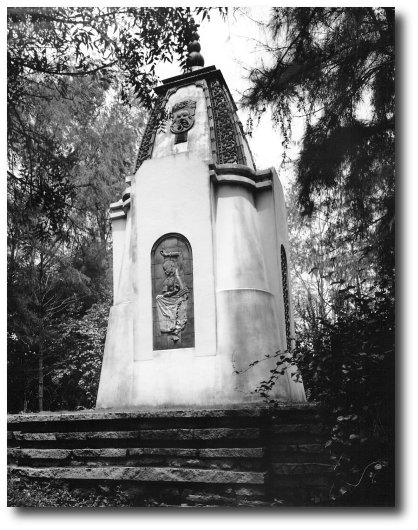
|
|
Temple - Dance School, Bangalore, India TMax100 film, 1/15sec, f/22 110mm Schneider Super Symmar XL f/5.6 |
I showed a friend some prints from these places. I wasn't entirely happy with my work and was looking for help. When I looked at my work there was something missing. Everything appeared flat. My friend made some timely suggestions and gave some valuable guidance. I immediately put his suggestions into my photographic practice. One of the side comments he made was how nice it would have been to have a little perspective control on the vertical lines. Many of my images were of rock carvings that were situated rather high up on the face of the temples. I had pointed the Rollei and Mamiya upward and the result was a keystone effect that is immediately noticable to large format photographers. My friend suggested that a nice light 4x5 kit might solve the architecture photography challenge of perspective control.
I liked what my friend said about composition. I am forever in his debt.
Additionally, I liked what
he said about deploying image controls. And I really liked the idea
of producing a larger negative than the 120 format I have been used to.
4x5 is just about the right size for me
and the kinds of images I enjoy printing. So I set about gathering even
more photographic gear. I now had a new goal. I needed to build a super
light weight 4x5 format kit in time to take it with me on my next
trip to South Asia.
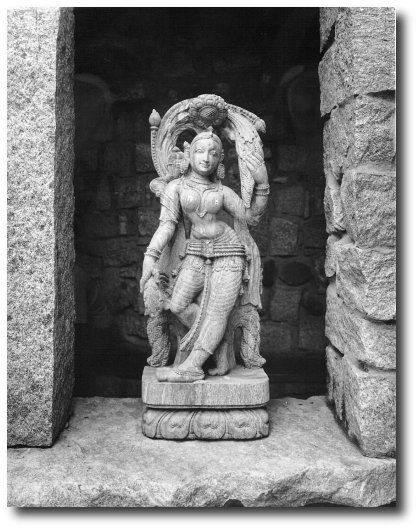
|
|
Goddess - Dance School, Bangalore, India TMax100 film, 1/30sec, f/22 110mm Schneider Super Symmar XL f/5.6 |
The next thing I considered was which lenses to take. In a very short time my friend sold me a beautiful 150mm Docter Optic Germinar f/9 (which is compared elsewhere on this site to a Fujinon 150mm W/EBC f/5.6). Just as quickly I found a very small and very light Schneider 90mm Angulon f/6.8 (also compared elsewhere on this site, this time against a 110mm Super Symmar XL). I already had and frequently used a Nikon 200mm M f/8 lens. All up, the three lens kit would weigh less than 520 grams, or just about 1 and 1/4 pounds. The only single coated lens was the Angulon, and it had only four air surfaced to bounce light off of. A single coating on that fine lens would be sufficient.
I already owned a very nice light, compact tripod. The tripod had been used on a previous trip with the Mamiya 7 and Rolleiflex. It was compact enough to fit inside my carry on luggage and stout enough to keep the 120 cameras stable. I confirmed it would adequately hold the Anba camera with a light lens. Then I moved on to consider what to do about film. I didn't want to haul a stack of reloadable film holders. I was concerned about dust and finding a place dark enough to load the holders. Besides that I was worried about what might happen when I run out of holders in the middle of a fast, furious, long photo shoot. My friend recommended I try Kodak Readloads. The local camera shop had plenty of new film holders so I bought one. Before I left on the trip I used the holder to make sure I didn't do something stupid while I was 1/2 way around the earth trying to have a good time with photography.
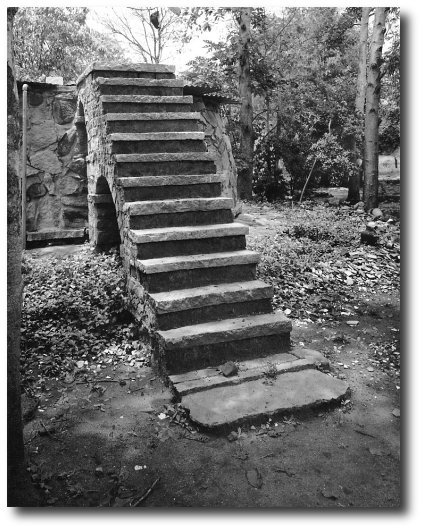
|
|
Stairs to the Cistern - Dance School, Bangalore, India TMax100 film, 1/8sec, f/22 110mm Schneider Super Symmar XL f/5.6 |
But then I got cold feet.
The entire kit had been built with weight as the primary consideration. I had succeeded in implementing this goal. But had I given up something important? As I noodled the situation I realized what it was that nagged me. I had given up image coverage by choosing the 90mm Angulon. The lens is only an 80 degree coverage optic. It might be very sharp and very light, but it barely covered the format. The more I thought about it, the more I realized I really had only one choice. I needed to replace the 90mm Angulon and the 150mm Germinar W with my very favorite slightly heavy hugely expensive but massive coverage Schneider 110mm Super Symmar XL f/5.6 aspheric optic.
By making this decision I was trading ultimate light weight in favor of something I was familiar with. I needed coverage for tall architectural subjects. And if there's one thing India abounds in it is tall interesting photogenic architectural subjects. My Schneider wonder lens needed a trip to India. It was the right thing to do.
The Schneider 110XL weighs 425grams and replaced the 135 gram 150mm Germinar W and 130 gram 90mm Angulon. Now all I had were two lenses, a camera, a film holder, three boxes of Kodak TMax100 readyloads, a small tripod, a dark cloth, the cheap focusing magnifier and the DigiSix light meter. The setup was thereby simplified. If only a little. I didn't realize at the time just how much the Schneider lens would be used.
Somehow enough room was needed in the suitcase
for a few clothes along side my photography toys.
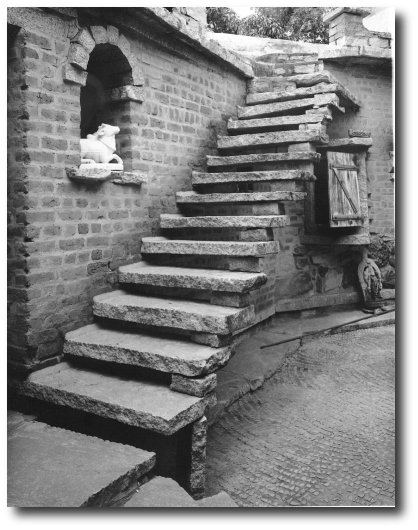
|
|
Stairs - Dance School, Bangalore, India TMax100 film, 1/15sec, f/22 110mm Schneider Super Symmar XL f/5.6 |
Another thing I was concerned about was the amount of attention I might attract wherever I used the camera. Crowds don't daunt me. But I also knew I'd be under the focusing hood sometimes and the over the shoulder bag might be ripe for the picking. In short, I was concerned about theft. On this point I should have known better. Indians are the most friendly people I have ever met and most are also very honest. What's the worse that would happen? Someone might end up with a gadget they couldn't use nor had any idea what it was?
Setting aside these concerns I loaded the tripod into the main luggage (which
I carry on to the aircraft and stow in the overhead bin) and put the
camera, lenses, and film into my
over the shoulder bag (which is also carried onto the plane).
Worrying a little over the amount of space the camera would take up was
very foolish of me. I had plenty of room. In fact, there
was so enough room for the various gifts and items for my Indian friends.
The gifts included the entire eight year TV series of MASH.
It consisted of 8 boxes, each
holding several DVDs. There was so much room that I was even able to
carry a large selection of chocolates and other sweets.
But was there enough room for my clothing? That was the question.
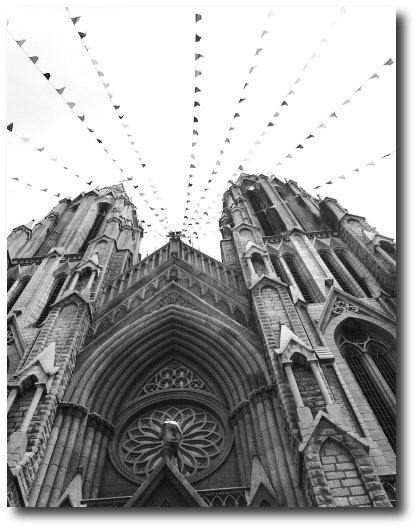
|
|
St. Philomina's Church - Mysore, India TMax100 film, 1/15sec, f/22 110mm Schneider Super Symmar XL f/5.6 |
This was the location where the Anba 4x5 would see its first use in India. I quickly realized that the 110mm Schneider Super Symmar XL was the perfect focal length for the situation. After fumbling a little (possibly suffering from jet lag) I entered a nice photography pace. The Anba was a easy to use after I remembered to close the shutter and to stop the lens down prior to pulling the film sheath. I only ruined one exposure.
I was quite taken by the windows on curved surfaces. The stairs around the property were very interesting too. A mixture of brick and rough hewn granite was used for the basic constuction. A plaster-like material was applied to the exterior of the living quarters. It looked like natural earth was used to make the plaster. The earth in this part of the world contains iron which colors the ground a nice bright red. So too was the color of the buildings that had been plastered. The windows were outlined with a nice repeating pattern painted on the walls.
For all my initial fumbling and trying to remember how to use the 4x5 kit
I missed some wonderful opportunities for portraiture. It started with a small
group of young women. Their eyes were bright, large, and they were
quite curious what I was up to. I wish I had engaged them to ask for their
photo. The setting was perfect. The sky overcast and the lighting would
have been perfect. Alas, I was concentrating on photographing stone and
window. Sometimes I have no idea what gets into my head!
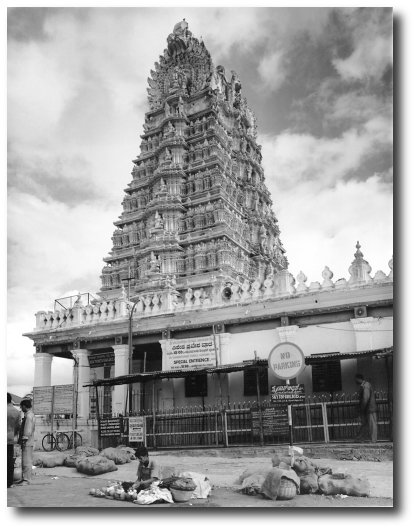
|
|
Temple to Chamundeeswari - Mysore, India TMax100 film, orange filter, 1/15sec, f/22 110mm Schneider Super Symmar XL f/5.6 |
Being on the street, people were taking an interest in what I was doing. One fellow looked and looked and looked. When I was finished he even followed me back to the car. I don't know if he wanted to talk about the camera or if he wanted money for one reason or another. Either way, I didn't give him much of a chance to engage in conversation. I didn't want to hold my colleagues up any more than I already had.
Once when I poked my head out from under the dark cloth I noticed a monkey wandering around the edge of the temple. This was the first time I saw monkeys this far into the city. Upon closer inspection, there were several monkeys. They would wander up the exterior of the heavily carved temple to the very tops of the spires. They had a lazy gait about them. I have no idea what they were doing there except living. It must be a good life as I watched as someone came out and held up fruit for one of the monkeys to take and eat. The monkeys appeared to be well fed.
One situation required the 200mm Nikkor M f/8. It worked well for "pulling"
detail out of a complex scene. The only problem was that I forgot to
use perspective controls to get the foreground lingam into focus. Otherwise,
the image is rather pleasing to me. I like the dancing god at the base
of the Asoka pillar, the flowers, and the pastes. While I worked on the
image several fellows came by and worshipped the idol. I didn't like
disrupting their worship, but things seemed to work out fine. The leaf
shutters are relatively quiet and the street noise drown out most of
my motions and actions as I worked the camera. This was one of the few
times I used the 200mm lens on this trip. Good thing it is very small and
light.
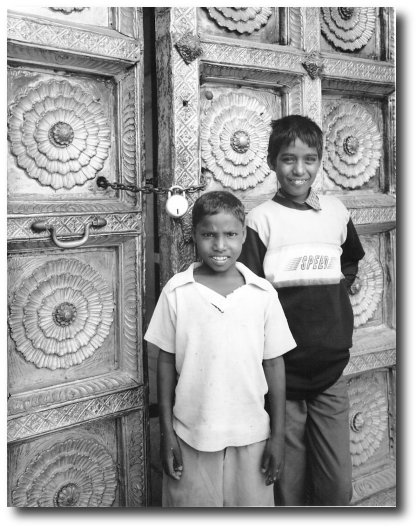
|
|
Boys - Temple, Maharaja's Palace, Mysore, India TMax100 film, 1/8sec, f/11 110mm Schneider Super Symmar XL f/5.6 |
The only thing I was missing was some sense of how to photograph people. The 4x5 camera seemed too slow to use for portraiture in a fast paced city environment. Additionally, the camera seemed to attract attention. But thus far the attention was not bothersome. No one had attempted to steal anything from my over the shoulder bag as I worked under the focusing cloth. My business trip was off to a grand start.
After several days of work and after a very early morning and very important quarterly review with the Big Boss (the VP of all that's wonderful at the workplace) my colleagues and I asked our driver to take us to Mysore.
I love India. It's a fine combination of order and chaos all mixed
into one. For example, the roads, traffic, and congestion provides
for a very entertaining environment. There is a strict hierarchy
to travel on the open highways. First, vehicles follow the British
system, that is to say, everyone drives on the left side of the road.
Many times just off the road are buildings, shops, and homes. This
is where the children, chickens, and dogs play. Then come people who
simply walk from place to place.
Sometimes they walk close to the buildings. Sometimes they
walk on the pavement of the road itself. Then come people who travel
by bullock cart. These large and many times overburdened carts can
be pulled by one or two huge animals who have the most beautiful
eyelashes. Here are these beasts of burden, looking lovely, hauling
just about anything that needs hauling. Next in the hierarchy come
the small displacement scooters. Or as they are called in India,
scooties. A little further out on the pavement
come the larger displacement motorcycles. These sometimes include
the deep rumbling Royal Enfield Bullet motorcycles.
Next we come to the small cars. Drivers even here are sometimes
seen wandering slightly in their "lane" while jabbering away on cell
phones. The larger cars are next. These travel as quickly as conditions
allow very near the center line of the road.
Now we come to the trucks. This heavy equipment
may or may not be in good operating condition. They are obligated to
take as much road as they feel fit. Last, but certainly not least,
come the intra-city buses. These may be manufactured by Tata and
the front steering may or may not be tight. Many times a person
can watch as these buses are herded down the road with people hanging
out while holding on to the railing at the door and as the driver
works the steering wheel while the tires wobble and wander which ever
way they will. The wheel wobble is seemingly independent of the
steering input from the driver.
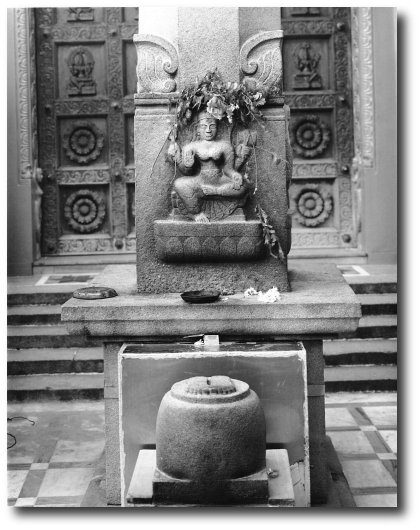
|
|
Idol - Temple, Bangalore, India TMax100 film, 1/15 sec, f/11 200mm Nikkor M f/8 |
The above explains the strict hierarchy of vehicles and traffic on the open road. If that's all there was, it would be nothing by Western standards. But add to this the fact that everyone is over taking, passing, or otherwise trying to get around everyone else who is lower on the traveling pecking order. The result is variously three to eight "lanes" wide of traffic operating in both directions. On a two lane road.
Drivers have travel on the open road down to a fine art. Passing and merging. Passing and merging. The honking of horns. Please move as I'm coming through. You can watch as a professional driver passes with just the right "touch". You can see how the on-coming lorry or bus passes in the opposite direction with inches to spare off the drivers side front fender. Except for once. That was when an on-coming Tata bus left a one inch wide three inch long "racing stripe" on the rear-view mirror. It was the only time I became alarmed. But the entire event was done and over with so quickly that I nearly missed the pleasant scene of rice paddys and sugar cane fields just off the Starbord Beam. Ah, glory. The green colors are vibrant and almost as eye searing as the green colors found in Japan.
Once safely arrived in Mysore we visited the Maharaja's Palace and Chamundi Hill.
Three years ago I met a local photographer. He asked me to take his photo with my Mamiya 7 and to send him a print. I figured I'd never see him again. But standing right where I seemingly left him several years back there he was. We chatted and caught up on "old times". He said he really liked the razor sharp B&W print I sent him. And we talked a little about his age and his photo hobby. It was pleasant.
This was the start of quite a day. Everywhere I went at the palace people
would come up to me individually or in large family groups. They would look
at the camera. They would peer at the ground glass. They would watch
as I worked the camera. But most of all, they would ask questions. "Where
are you from?" "How much did the camera cost?" "Do you know where I'm
from?". It was great fun. I made so many friends. Some came from
Andra Pradesh. Others were from right there in Karnataka. Still others
traveled from Kerala. The Ikeda Anba worked like a beacon, a giant kiosk,
a wonderful rallying point. I have to say, this was one of the best
times I've ever had while out and about taking photos. Some of the images
taken that day are even good enough to print. My only disappointment was
that I didn't turn my camera on my questioners. I missed many opportunities
for fun and interesting images. Oh well. It's only half way around the
other side of the world from me now.
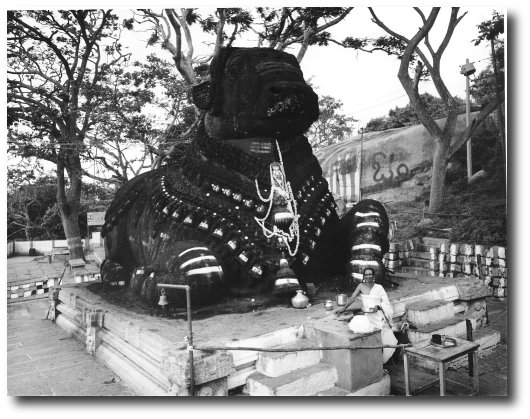
|
|
Nandi - Temple, Chamundi Hill, Mysore, India TMax100 film, orange filter, 1/8sec, f/22 110mm Schneider Super Symmar XL f/5.6 |
The doors on the east temple at the Mahraja's Palace were finished in a striking gold gild. They were heavily and nicely carved. I wanted to get a photograph of them before the temple closed for lunch. Alas, just as I walked up the pujari came out and locked the doors. He and I spoke for a moment or two before he wandered off. Since the doors were so beautiful I decided to photograph them closed. The lock, after all, was fairly striking against the gilded wood. I completed making one image when a pair of young boys came up and asked what I was doing. Indians are quite friendly and I was having a good time chatting with them. I'm a little slow sometimes, but the thought occurred to me to ask if I could have their photograph. They gleefully agreed. After setting up the shot I talked them through the process of how I insert the film holder, pull the film sleeve, trip the shutter, and remove the film from the camera. They were delighted at all this. Of course it was a setup. After patiently listening to me babble on about this and that, they held out their hands for money. They wanted to be paid for being my models. I pulled out a 50rs note and asked if they could share the proceeds. They were very happy and we Namaskar'd each other as they walked away. Perfect. Exactly what I was looking for. A nice photo of people from the Anba. It cost me a whole buck.
The second incident involved a pujari or purohit, a large solid granite carved Nandi, and patience. On Chamundi Hill there are several beautifully carved Nandi. One in particular is quite large and many hunderds of years old. It has been continuously worshipped for centuries. When we arrived there was no one there except the pujari and a few vendors. The bull stood magnificiently in the background. As I worked the camera I realized the pujari was striking poses in each frame. I thought this was pretty neat and happily exposed a couple more frames before I realized I needed to compensate my exposures for the orange filter that I had foolishly installed on the back of the 110 Super Symmar XL. With two frames wasted I settled down and got serious about making images. Just as I was finishing up the pujari came up on the platform we were standing on and gave us prasad and marked our foreheads with a crimson powder. He had been patiently waiting for me to take his picture. Now was his time to do what he did best. I knew I needed to give him something. Out came another 50rs note and I asked him if this could cover my colleague's offering as well. Everyone was smiling. All was right with the world. I had bagged a few more images.
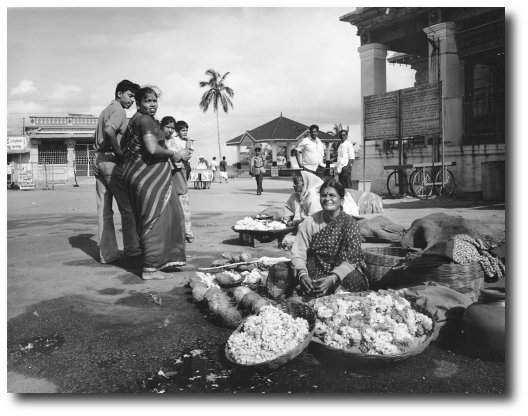
|
|
Vendors - Temple, Chamundi Hill, Mysore, India TMax100 film, orange filter, 1/15sec, f/22 110mm Schneider Super Symmar XL f/5.6 |
Regarding my experiment of hauling a 4x5 view camera across the globe
to have only two days of photography, I wouldn't miss it for the world.
I found that 110mm's is just the right focal length for many of the things
I like to photograph. I found the camera to be simple and realitively
quick to use. I found Kodak Readyloads to be the god's gift to hobby
photographers. And I found that I need to throw a Rolleiflex TLR into
the kit the next time I go. The 120 format camera will need to find a
way to get along with its bigger brother, the 4x5 field camera.
Besides, a Rollei will be great for quickly capturing a few people images.
The photographic wheel continues to turn.
Email if interested in providing comments or feedback: Christopher Perez